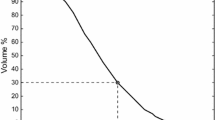Abstract
Selecting a number of beams and their orientations in intensity-modulated radiation therapy (IMRT) is an important, but large-scale NP-hard optimization problem. Unfortunately, the quality of beam directions depends heavily on its corresponding beam intensity profiles. Usually, the number of beams is manually pre-determined and passed for a stochastic selector which optimizes beam orientations, and then a single objective inverse treatment planning algorithm is used for optimizing beam intensity profiles. The overall time needed to solve the inverse planning for every random selection of beam orientations becomes excessive. Therefore selecting an appropriate set of beam directions in IMRT is still a time-consuming manual trial-and-error search procedure that depends on intuition and empirical knowledge. During the last decade considerable progress has been made in optimizing beam intensity profiles by using multi-objective inverse treatment planning. Multi-criteria optimization results in a variety of beam intensity profiles for every selection of beam orientations. The planner then needs to search, manually, through this variety of solutions to decide upon an optimal plan. This work takes advantage of this human interaction to present a two-phase algorithm in which both processes of beam orientations and multi-criteria optimization with human guidelines cooperate together to determine a suitable number of beams and their orientations in a clinically practical time-slot. To illustrate the efficiency of the algorithm it has been applied to one artificial example and three real clinical cases. The results show that using the algorithm, both target coverage and sparing critical structures were significantly improved compared to the standard equally spaced beam plans. Moreover in some cases the algorithm suggested plans with one beam fewer than the equally spaced beam plans without compromising the quality of the treatment plan.







Similar content being viewed by others
Notes
Without loss of generality, it is assumed that the irradiated volume consists of the target and one organ at risk.
References
Bortfeld T (1999) Optimized planning using physical objectives and constraints. Semin Radiat Oncol 9:20–34
Bortfeld T (2010) The number of beams in IMRT—theoretical investigations and implications for single-arc IMRT. Phys Med Biol 55:83–97
Bortfeld T, Schlegel W (1993) Optimization of beam orientation in radiation therapy: some theoretical consideration. Phys Med Biol 38:291–304
Bortfeld T, Burkelbach J, Boesecke R, Schlegel W (1990) Methods of image-reconstruction from projections applied to conformation radiotherapy. Phys Med Biol 35(10):1423–1434
Cotrutz C, Lahanas M, Kappas C, Baltas D (2001) A multiobjective gradient-based dose optimization algorithm for external beam conformal radiotherapy. Phys Med Biol 46:2161–2175
Craft D, Halabi T, Shih HA, Bortfeld T (2007) An approach for practical multiobjective IMRT treatment planning. Int J Radiat Oncol Biol Phys 69(5):1600–1607
D’Souza WD, Meyer RR, Shi L (2004) Selection of beam orientations in intensity-modulated radiation therapy using single-beam indices and integer programming. Phys Med Biol 49(15):3465–81
Ehrgott M, Holderb A, Reesed J (2008) Beam selection in radiotherapy design. Linear Algebra Its Appl 428:1272–1312
Hall EJ (2006) Intensity-modulated radiation therapy, protons, and the risk of second cancers. Int J Radiat Oncol Biol Phys 65:1–7
Küfer KH, Scherrer A, Monz M, Alonso F, Trinkaus H, Bortfeld T, Thieke C (2003) Intensity-modulated radiotherapy—a large scale multi-criteria programming problem. OR Spectr 25:223–249
Küfer KH, Monz M, Scherrer A, Süss P, Alonso F, Azizi-Sultan AS, Bortfeld T, Thieke C (2009) Multicriteria optimization in intensity modulated radiotherapy planning. In: Pardalos PM, Romeijn HE (eds) Handbook of optimization in medicine. Kluwer, Boca Raton
Mohan R, Wang X, Bortfeld AJT, Boyer A, Kutcher G, Leibel S, ZFuks, Ling C (1994) The potential and limitations of the inverse radiotherapy technique. Radiother Oncol 32(3):232–248
Monz M, Küfer KH, Bortfeld T, Thieke C (2008) Pareto navigation: algorithmic foundation of interactive multi-criteria imrt planning. Phys Med Biol 53:985–98
Nazareth DP, Brunner S, Jones DM, Malhotra HK, Bakhtiari M (2009) Optimization of beam angles for intensity modulated radiation therapy treatment planning using genetic algorithm on a distributed computing platform. J Med Phys 34(3):129–132
Niemierko A (1997) Reporting and analysing dose distriputions: a concept of equivalent uniform dose. J Med Phys 24:103–110
Pollack A, Zagars GK, Antolak JA, Kuban DA, Rosen I (2002) Prostate biopsy status and psa nadir level as early surrogates for treatment failure: analysis of a prostate cancer randomized radiation dose escalation trial. Int J Radiat Oncol Biol Phys 54(3):677–685
Pugachev A, Xing L (2001a) Computer-assisted selection of coplanar beam orientation in intensity-modulated radiation therapy. Phys Med Biol 46:2467–2476
Pugachev A, Xing L (2001b) Pseudo beam’s-eye-view as applied to beam orientation selection in intensity-modulated radiation therapy. Int J Radiat Oncol Biol Phys 51:1361–1370
Pugachev A, Li J, Boyer A, Hancock S, Le Q, Donaldson S, Xing L (2001) Role of beam orientation optimization in intensity-modulated radiation therapy. Int J Radiat Oncol Biol Phys 50:551–560
Rowbottom C, Nuttingb CM, Webba S (2001) Beam-orientation optimization of intensity-modulated radiotherapy: clinical application to parotid gland tumours. Radiother Oncol 59:169–177
Söderström S, Brahme A (1995) Which is the most suitable number of photon beam portals in coplanar radiation therapy? Int J Radiat Oncol Biol Phys 33:151–959
Stein J, Mohan R, Wang X, Bortfeld T, Wu Q, Preiser K, Ling C, Schlegel W (1997) Number and orientations of beams in intensity-modulated radiation treatments. Med Phys 24:149–160
Yang R, Dai J, Yang Y, Hu Y (2006) Beam orientation optimization for intensity-modulated radiation therapy using mixed integer programming. Phys Med Biol 51:36–53
Acknowledgments
I would like to thank Professor K.-H. Küfer at the Optimization Department of Fraunhofer Institute for Industrial Mathematics, Germany. Without his support this work would not have been completed.
Author information
Authors and Affiliations
Corresponding author
Rights and permissions
About this article
Cite this article
Azizi-Sultan, AS. Pseudo-automatic beam orientations in multi-criteria intensity-modulated radiation therapy. J Comb Optim 31, 1746–1759 (2016). https://doi.org/10.1007/s10878-015-9867-9
Published:
Issue Date:
DOI: https://doi.org/10.1007/s10878-015-9867-9




